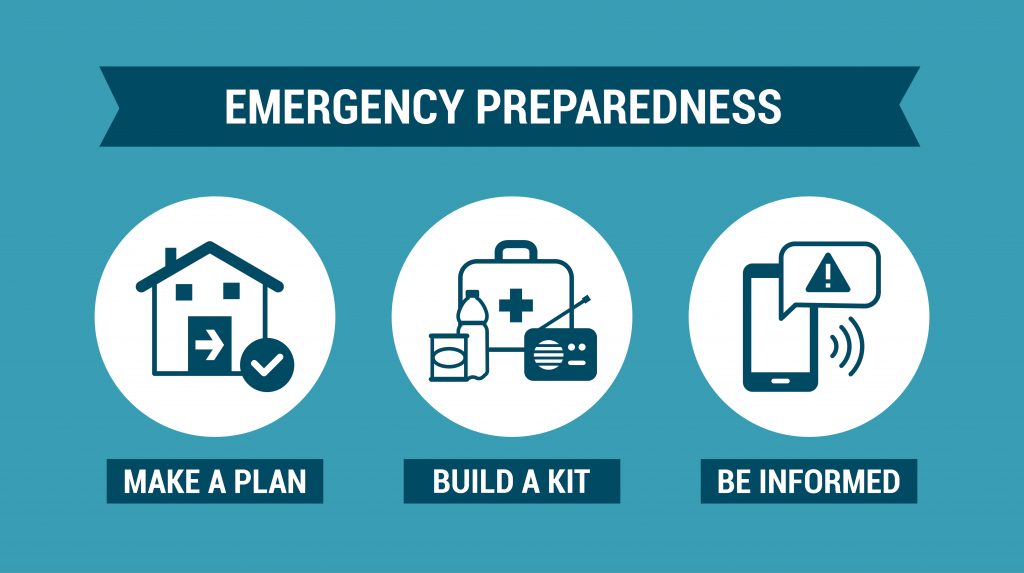
September is National (Emergency) Preparedness Month, and in observance, the Minnesota Council on Disability (MCD) strongly encourages you to explore our emergency preparedness materials.
The COVID-19 pandemic demonstrated how quickly our world can change and why everyone must be prepared, not just people with disabilities. Being informed, making a plan, and assembling an emergency bag or kit can save your life!
Phases of the Emergency Management Framework
Preparedness is just one phase of a larger Emergency Management Framework.
The Emergency Management Framework assumes that communities are always in at least one phase of emergency management. The framework guides individuals, and community, state, and federal agencies through the four phases of successful emergency management: mitigation, preparedness, response, and recovery.
Mitigation
Mitigation is any action taken to prevent or reduce a disaster or emergency’s cause, impact, and damaging effects. Examples include:
- Buying home or car insurance,
- Strengthening communication access for Deaf and Hard of Hearing (HOH) populations, or
- Removing architectural barriers to improve access for people with disabilities.
Preparedness
Preparedness includes planning, training, and educating yourself and others. Practicing fire and tornado drills are examples of preparedness. When preparing for an emergency, consider the following questions:
- What will you do in an emergency?
- Who will you communicate with if you need help?
- Where would you go if you needed to seek shelter outside of your home?
MCD offers the following emergency preparedness materials:
- A Go and Stay bag,
- A plan of action checklist,
- A farmers and ranchers preparedness checklist,
- Railway preparedness information,
- Forms to keep track of your medical and personal information.
Remember: Preparedness can extend beyond people. Plan for your pets and service animals, too!
Response
A response consists of actions taken right after a disaster happens. Conducting a search and rescue is an example of a response. The ability to respond to an emergency relies on how well we mitigate effects beforehand. For example, knowing what shelters are accessible to your needs will affect how quickly you can act during an evacuation.
Recovery
Once the immediate danger of the emergency is over, recovery and restoration efforts begin. Depending on the situation, this period can last a short or a long time. Examples of recovery include:
- Rebuilding damaged buildings and
- Preventing or reducing illness due to stress.
Emergency Management Roles
While individuals must participate in emergency management planning, community, state, and federal government agencies have their roles.
Community Agency Roles
Community agencies – such as the Red Cross and other faith-based groups and civic organizations – work together to plan for evacuations, emergency shelters, sheltering in place, and food distribution. These organizations then connect with state officials to make a State Emergency Plan.
State Agency Roles
The Minnesota Department of Public Safety, Division of Homeland Security opens a State Emergency Operations Center (SEOC) when an emergency is declared. Most state agencies send a representative to the SEOC to address all aspects of public life during an emergency. Agencies might include:
- Minnesota Department of Transportation,
- Minnesota Department of Health,
- Minnesota Pollution Control Agency, and
- Minnesota Council on Disability.
These agencies will work with local governments and the community organizations listed above to support ongoing emergency management efforts.
Federal Agency Roles
When the President of the United States declares an emergency, The Federal Emergency Management Agency (FEMA) supports citizens and emergency personnel to follow the Emergency Management Framework.
Questions?
Do you still have questions about preparedness? Check out our Emergency Preparedness FAQ, and be sure to follow MCD on Facebook and Twitter throughout September for more information on how you can prepare.
Call us at 651.361.7800 or email MCD for a printed copy of our emergency plan folder.